1The solubility of carbide grain inhibitor in the bonding phase.
Generally, the less stable the inhibitor is, the higher its solubility in the bonding phase, and the more obvious its effect in inhibiting grain growth.
2The eutectic temperature of the inhibitor and Cobalt.
Among the existing grain growth inhibitors, VC and Cr3C2?have the lowest eutectic temperature with Co, and their solubility in the bonding phase is the highest, too. Therefore, they have the most significant effect in inhibiting the growth of WC grains.
Therefore, Meetyou?conducts this?laboratory research on grain growth inhibitors VC and Cr3C2. This research studies the content and particle size of the two inhibitors when added alone or in combination, and their effects on the mechanical properties of WC-10 Co hard alloys. We’ll learn about the ideal proportion of the two inhibitors by our experimental research.
Test Data
The effect of adding a single inhibitor, Cr3C2?and VC, on the performance of WC cemented carbide
0.5 μm of VC or Cr3C2?was added to the alloy. The relationship between the amount of?carbide grain?inhibitor added and the hardness of the alloy is shown in Figure 1 and Figure 2.
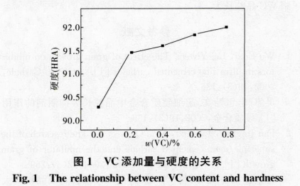
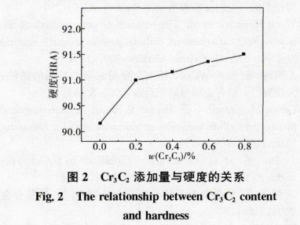
From Figure 1 and Figure 2, it can be seen that under the same alloy preparation process, with the increase of Cr3C2 content, the hardness of the alloy shows a gradually increasing trend, and VC is more effective than Cr3C2 in improving the alloy hardness. From Figure 3 and Figure 4, it can also be seen that the cemented carbide with added VC carbide grain inhibitor has a relatively small and uniform grain size, especially avoiding the occurrence of large particles, so its hardness is slightly higher than that of the cemented carbide with added Cr3C2.
The impact of inhibitors with different particle sizes on the performance of cemented carbide
In this experiment, VC powder and Cr3C2 powder were chosen as inhibitors, with a ratio of m(Cr3C2)/m(VC) = 0.5/0.5. The performance of the prepared cemented carbide is shown in Table 1.

From the data in Table 1, it can be visually seen that as the particle size of the inhibitor decreases, the hardness of the cemented carbide gradually increases. This is because the smaller the particle size of the inhibitor, the more uniform the distribution of the resulting cemented carbide after ball milling, and the more significant the inhibitory effect on the WC grain size. In addition, due to the refinement of the WC grain size, the hardness also increases. From the experimental data listed in Table 1, it can also be seen that the comprehensive performance of ultrafine WC-Cobalt 10% carbide grain inhibitor is better when the particle size of the inhibitor is 0.5 μm, and the density can reach 98.9, and the HRA hardness can reach 91.9.
The influence of different ratio amounts of carbide grain inhibitor
VC, Cr3C2, tantalum carbide, and niobium carbide are used as inhibiting additives to inhibit the growth of WC grains. They form a solid solution with WC or are preferentially dissolved in the metallic liquid phase binder. This mechanism increases the hardness of WC but is detrimental to the strength of the cemented carbide. The main reason for the decrease in strength is the unevenness of the WC grains, that is, the presence of locally coarse grains. Therefore, in the manufacture of ultrafine cemented carbide, the uniformity of the microstructure should be noted. The non-uniform distribution of any carbide grain?inhibitor will lead to local WC grain coarsening and the formation of cobalt pools. Therefore, this experiment uses composite inhibitors to balance the properties of cemented carbide. VC and Cr3C2 inhibitors have this synergistic effect. Therefore, in this experiment, WC-Co 10% is used as the research matrix, and the total amount of composite inhibitors of VC/Cr3C2 is controlled within 1.0%. Table 2 shows the properties of cemented carbide obtained by changing the different ratio amounts of VC/Cr3C2.
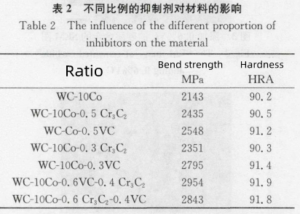
According to Table 2, when 0.6VC-0.4Cr3C2 inhibitor is added, the bending strength of ultrafine-grained cemented carbide is 2954 MPa and the hardness is 91.9, showing better comprehensive properties. Figures 5(a) and (b) are SEM images of cemented carbide with and without the addition of 0.6VC-0.4Cr3C2 inhibitor, respectively. By comparing Figure 5 with Figures 3 and 4, it can be seen that the WC grains in cemented carbide with 0.6VC-0.4Cr3C2 inhibitor added are small and uniform, so its bending strength and hardness are high.
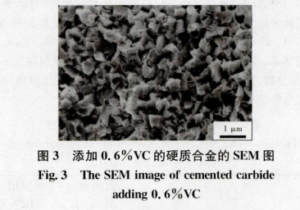

Working mechanism of grain inhibitor
The main function of the carbide grain inhibitor is to suppress the excessive growth of tungsten carbide grains during the sintering process, ensuring good hardness and strength of the material. As the inhibitor content increases, the trend of grain growth becomes less obvious, and the hardness of the cemented carbide becomes higher. To improve the strength of cemented carbide, it is also necessary to add inhibitors with different compositions, i.e., adding composite inhibitors during the sintering process, and the proportion of the two inhibitors should be appropriate. According to the results of this experiment, the order of the effectiveness of grain growth inhibitors in improving the strength of WC-Co-based cemented carbide is VC+Cr3C2>Cr3C2>VC.
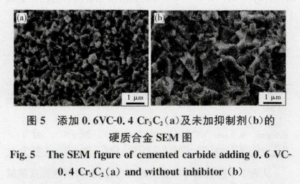
The study shows that V was not detected in the cobalt phase of WC-Co cemented carbide with VC added alone by energy dispersive X-ray spectroscopy (EDXS). However, Cr3C2 was found in the cobalt phase of cemented carbide with Cr3C2 added alone, but the distribution of Cr3C2 was uneven. Near the interface of Co/WC, the content of Cr3C2 was higher than that in the diamond phase and enriched on the basal and edge planes of WC grains. VC adsorbs on the surface of tungsten carbide particles, reduces the surface energy of WC, reduces the solubility of WC in the liquid phase, inhibits the dissolution and growth of WC grains, and V will segregate after cooling and precipitate as (V, W)C at the WC/y and WC interfaces, which hinders the migration of WC grain boundaries and prevents the aggregation and growth of WC particles. Cr3C2 dissolves in the liquid phase cobalt, slowing down the liquid-phase recrystallization of WC.
S? k?t lu?n
- Under the same preparation process of cemented carbide, the addition of single Cr3C2 content gradually increases the hardness of the cemented carbide, and VC is more effective than Cr3C2 in improving the hardness of the cemented carbide.
- The smaller the particle size of the inhibitor, the more obvious the inhibitory effect on the growth of tungsten carbide grains; at the same time, due to the refinement of WC grains, the hardness also increases. When the particle size of inhibitor is 0.5 μm, the comprehensive performance of the alloy is better, and the density can reach 98.9 and the hardness (HRA) can reach 91.9.
- When 0.6VC-0.4Cr3C2 inhibitor is added, the comprehensive performance of the ultrafine-grained cemented carbide is better, and the WC grains are fine and uniform, with a bending strength of 2954 MPa and a hardness of 91.9. (4) By analyzing the mechanism of the inhibitor, it can be known that both VC and Cr3C2 can inhibit the growth of WC grains.









